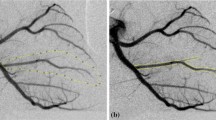Summary
Simultaneous in vivo infusions of two different colored 10 μm microsphere suspensions into the left anterior descending (LAD; red spheres) and left circumflex (LCx; blue spheres) coronary arteries of nine anesthetized dogs identified a specific region of canine myocardium perfused by both arterial branches. Subsequently, the LAD was ligated and a third (green) set of micropheres was infused into the patent LCx artery. Analysis of 40 μm serial sections of tissue revealed interface zones with capillaries perfused by both arteries. The first zone, defined as the Interface Transistion Zone (ITZ) was formed by an intermingling of microvessels supplied by the parent arteries of the adjacent perfusion territories; it separated tissue containing only one or the other colored microspheres. Another zone, defined as the Boundary Watershed Zone was located within the ITZ and had capillaries containing both red and blue microspheres. The width of ITZ was 53377±817 μm (mean±SD), and the width of the BWZ was 3358±618 μm. Green microspheres, infused into the LCx following coronary occlusion were also found in the ITZ and BWZ. Furthermore, capillaries perfused exclusively by the LAD before occlusion (tissue with red but not blue microspheres) adjacent to the perfusion interface contained green microscpheres as well as red/green aggregates, indicating lateral extension of the LCx perfusion territory. This extension of the LCx territory was quantitated by comparing the location at which densities of green microspheres or green/red aggregates decreased abruptly compared to the location of the original ITZ and BWZ boundaries, respectively. Results showed that LAD occlusion caused a 24% expansion of the ITZ and a 48% expansion of the BWZ. In addition, all expansions were significantly greater in subepicardial compared to subendocardial regions (p<0.001). These results clearly demonstrate the capability of microvascular anastomoses in providing blood flow to the periphery of an ischemic region. Furthermore, the perfusion interface is labile and might be amenable to manipulation.
Similar content being viewed by others

References
Baroldi G, Scomazzoni G (1967) Coronary circulation in the normal and pathogenic heart. U.S. Government Printing Office, Washington DC
Bassingthwaighte JB, Yipintsoi T, Harvey RB (1974) Microvasculature of the dog left ventricular myocardium. Microvasc Res 7:229–249
Becker LC, Ferreira R, Thomas M (1973) Mapping of left ventricular blood flow with radioactive microspheres in experimental coronary artery occlusion. Cardiovasc Res 7:391–400
Becker LC, Schuster EH, Jugdutt BI, Hutchins GM, Bulkley BH (1983) Relationship between myocardial infarct size and occluded bed size in dog: Difference between left anterior descending and circumflex coronary artery occlusion. Circulation 67:549–557
Brown RE (1965) The pattern of the microcirculatory bed in the ventricular myocardium of domestic mammals. Am J Anat 116:355–374
Cicutti N, Rakusan K, Downey HF (1992) Colored microspheres reveal interarterial microvascular anastomoses in canine myocardium. Basic Res Cardiol 87:400–409
Cohen MV (1985) Coronary Collaterals: Clinical and Experimental Observations. Futura, Mount Kisco, New York
Downey HF, Crystan GJ, Bockman EL, Bashour FA (1981) Functional significance of microvasular collateral anastomoses after chronic coronary artery occlusion. Microvasc Res 21:212–222
Eng C, Cho S, Factor SM, Kirk ES (1987) A nonflow basis for the vulnerability of the subendocardium. J Am Coll Cardiol 9:374–379
Factor SM, Okun EM, Kirk ES (1981) The histological lateral border of acute canine myocardium infarction: a function of microcirculation. Circ Res 48:640–649
Factor SM, Okun EM, Minase T, Kirk ES (1982) The microcirculation of the human heart: end-capillary loops with discrete perfusion fields. Circulation 66:1241–1248
Fulton WFM, Thomas CC (1965) The Coronary Arteries, Arteriography, Microanatomy, and pathogenesis of Obliterative Coronary Artery Disease. Charles C Thomas, Springfield, Ill
Grayson J, Davidson JW, Fitzgerald-Fitz A, Scott C (1974) The functional morphology of the coronary microcirculation in the dog. Microvasc Res 8:20–43
Griggs DM, Chen CC, Tchokoev VV (1973) Subendocardial metabolism in experimental aortic stenosis. Am J Physiol 224:607–613
Gumm DC, Cooper SM, Thompson SB, Marcus ML, Harrison DG (1988) Influence of risk area and location on native collateral resistance and ischemic zone perfusion. Am J Physiol 254:H473-H480
Hearse DJ; Yellon DM (1984) Why are we still in doubt about infarct size limitation? The experimentalist's viewpoint. In: Hearse DJ, Yellon DM (ed) Therapeutic approaches to myocardial infarct size limitation, Raven Press, New York, pp 17–38
Koyanagi S, Eastham CL, Harrison DG, Marcus ML (1982) Transmural variation in the relationship between myocardial infarct size and risk area. Am J Physiol 242:H867-H874
Okun EM, Factor SM, Kirk ES (1979) End capillary loops in the heart: an explanation for discrete myocardial infarctions without border zones. Science 206:565–567
Przyklenk K, Vivaldi MT, Malcolm J, Arnold O, Schoen FJ, Kloner RA (1986) Capillary anastomoses between the left anterior descending and circumflex circulations in the canine heart: Possible importance during coronary artery occlusion. Microvasc Res 31:54–65
Reimer K, Jennings RB (1979) The “wavefront phenomenon” of ischemic cell death. II. Transmural progression of necrosis within the framework of ischemic bed size (myocardium at risk) and collateral flow. Lab Invest 56:786–794
Schaper W (1971) The collateral circulation of the heart. Amsterdam: North-Holland Publishing Co.
Schaper W (1979) Residual perfusion of acutely ischemic muscle. In: Schaper W (ed) The pathology of myocardial perfusion; Elsevier, North-Holland Biomedical Press.
Schaper W, Görge G, Winkler B, Schaper J (1988) The collateral circulation of the heart. Prog Cardiovasc Dis 31:51–77
White FC, Bloor CM (1981) Coronary collateral circulation in the pig: correlation of collateral flow and coronary bed size. Basic Res Cardiol 76:189–196
Author information
Authors and Affiliations
Rights and permissions
About this article
Cite this article
Cicutti, N., Rakusan, K. & Downey, H.F. Coronary artery occlusion extends perfusion territory boundaries through microvascular collaterals. Basic Res Cardiol 89, 427–437 (1994). https://doi.org/10.1007/BF00788280
Received:
Accepted:
Issue Date:
DOI: https://doi.org/10.1007/BF00788280



